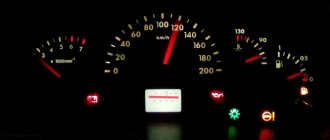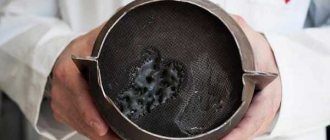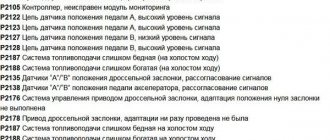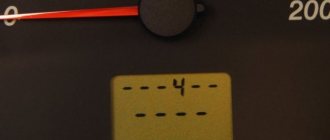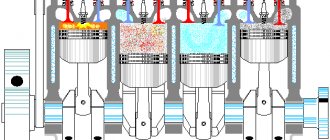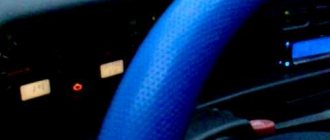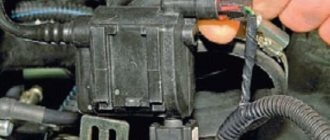Error code 0363 on grant 8 valve
The reason that error 0363 appears on the VAZ 2114 is the so-called misfire. It is the absence of an electric spark at the spark plug of one of the cylinders, as a result of which only three cylinders are involved in the operation of the engine.
The term “tripleting” of an engine precisely refers to the fact that the engine runs on only three of the four cylinders. Despite the fact that cars are now produced with a large number of cylinders, this concept continues to be used steadily.
Externally, tripping looks like a large loss of power, sharp jerking of the car and strong exhaust sounds. In most cases, the car will not even be able to move. This phenomenon can occur either periodically or constantly.
The reasons may be:
We will consider the first of these reasons (misfire) below.
Technical description and interpretation of error P0363
The P0363 error code is "misfire detected - fuel cut off." Often, in programs that work with an OBD-2 scanner, the name may have the English spelling “Misfire Detected - Fueling Disabled”.
A stored P0363 code indicates that the powertrain control module (PCM) has detected a misfire and has disabled the fuel injector for the affected cylinder. It can also be said that this problem is more common on cars of European origin.
The PCM monitors changes in input signals from the crankshaft position sensor (CPS) and camshaft position sensor(s) (CMPS). To determine whether a misfire is present and which cylinder is misfiring.
Initially, when a misfire is detected, the Malfunction Indicator Lamp (MIL) may flash rapidly for a period of time and stop (instead of staying on continuously). The flashing “Check engine” indicator is intended to inform the driver.
Movement combined with a cylinder misfire can damage the catalytic converter. The misfire code must be stored regardless of the MIL flashing, although it may be stored as a pending code.
In some vehicles (usually European manufacturers), when the PCM detects multiple cycles with a misfire code. Fuel supply to the affected cylinder is cut off.
This is typically achieved by disabling the fuel injector ground pulse for a specific cylinder. Shutting off the fuel supply to a particular cylinder is necessary because excess fuel can cause catalytic converter failure.
If a misfire is detected, a P0363 code will be stored, fuel supply to the affected cylinder will be cut off, and the MIL may illuminate. This problem is usually accompanied by one or more cylinder misfire codes.
Other misfire codes including P0300, P0301, P0302, P0303, P0304, etc.
Symptoms of malfunction
The main driver symptom of P0363 is the MIL (Malfunction Indicator Light). It is also called Check engine or simply “check light”. They can also appear as:
- Rough or intermittent engine operation, especially when accelerating.
- Reduced performance as well as engine power.
- Other misfire-related codes will likely be stored.
- The “Check engine” warning light may flash.
How to Troubleshoot or Reset Trouble Code P0363
Some suggested steps to troubleshoot and fix error code P0363:
Diagnosis and problem solving
The first step is always to check the technical service bulletins (TSB) for your specific vehicle. Your problem may already be known with a known fix released by the manufacturer. This can save you time and money during diagnosis.
Code P0363 is information on a stored cylinder misfire code. Any other stored pass codes will also need to be diagnosed. They are designated P0301 to P0312.
There are many tools available to test the operation of the coil, spark plug, and fuel injector. But the simple method of replacing components between cylinders is the most effective.
This is not always possible to do with fuel injectors, but it works well with coils and spark plugs. Which fail much more often than fuel injectors.
To fix the problem, you will need a scanner to read the saved codes. The scanner will also come in handy for clearing codes as the diagnostic process continues. After completing the steps to replace components, you must clear the codes to perform diagnostics.
It is best to replace spark plugs as a set if the vehicle in question is approaching the recommended replacement interval. However, locate the faulty part before performing any maintenance. When replacing the ignition coil for a specific cylinder, it is recommended to replace the spark plug. This will save you time and money in the long run.
Sometimes, when this problem is detected, some technicians assume that the injector of the relevant cylinder has failed. And they suggest replacing it, although this is simply a reaction (caused by the PCM) to a misfire. This is misleading if you are not familiar with the fuel cut-off system found on some models.
If P0363 persists without any cylinder misfire codes, suspect a faulty PCM or PCM programming error.
Additional diagnostic notes:
The P0363 code must be cleared before the faulty parts are replaced and the injector pulse on the corresponding cylinder is restored.
When using the replacement method to inspect spark plugs, be careful when removing the plugs from aluminum cylinder heads. The threads in aluminum are very fragile and can be damaged if they are not allowed to cool properly.
On which cars is this problem most common?
The problem with code P0363 can occur on different machines, but there are always statistics on which brands this error occurs more often. Here is a list of some of them:
- BMW
- Chevrolet
- Datsun (Datsun on-DO)
- Ford
- Hyundai
- Mazda
- Mini
- VAZ 2104, 2105, 2107, 2110, 2114, 2115
- Lada Vesta, Granta, Kalina, Largus, Priora, X-Ray
With fault code P0363, you can sometimes encounter other errors. The most common ones are: P0014, P1301, P1302, P1303, P1304, P1343, P1345, P1347, P1349, P1357.
Lada Kalina error 0363
Sometimes you get into the car, the key is turned to start, and the engine barely spins up, vibrates a lot, and troits, the check light comes on. However, as the engine warms up, it starts to run smoothly. But it jerks when moving under tension, or during rapid acceleration. With such symptoms, the first thing you need to do is, of course, read the error codes. If you have an on-board computer, then this is not a problem at all, if not, can diagnostics through the connector help?
Most often we will see two typical errors:
0363 - Misfire detected, fuel supply to idle cylinders is turned off
1303 - Cylinder 3, misfire detected, critical for the converter
In addition, we can get the following:
0300 and 0303 - Checking for misfires that affect toxicity. The number of misfires is greater than the threshold value
Full set of possible errors:
P0300, 0302, 0363, 1302, 0301, 1301, 0346, 1303
So, the problem should be looked for in this order:
4. Ignition module.
In 60% of cases, everything is solved by replacing the spark plugs with new ones; in rare cases, they pull wires along with them; the worst option is burnt-out valves, but this needs to be ruled out by measuring compression. In order to exclude the mass air flow sensor or the ignition module without losing money, I recommend taking them for analysis with the condition of being able to return them, or from the corefan, if he has a mark or a four. Good luck to everyone on the roads and fewer breakdowns.
Error codes that are logged as errors by the engine control module memory belong to a specific type of diagnostic information. The interpretation of codes is useful for any owner, including the owner of a Lada Kalina.
Through these encrypted information units, the process of self-diagnosis of all on-board electronic components in the car is carried out. This is very useful because it provides the ability to identify a malfunction before a critical failure of a system component occurs.
Reasons for the error: misfire, lack of fuel supply
Displaying Associated Error Codes P0363
Having identified the error code P0363, it is quite difficult to immediately determine the cause. In general, problems with the engine in such cases may lie in the fuel system, ignition, timing, electrical equipment, or in the engine design itself.
It is very common for codes P0363 and P1303 to occur at the same time. When checking a car in detail, you can find the following common faults:
When it produces two errors P0363 and P1301, P1302, P1303, P1304, then you should also pay attention to the performance of the high-voltage wires and ignition coils of a particular cylinder (1,2,3 or 4th, respectively).
According to many observations of the behavior of the engine when such errors are recorded, the following conclusion can be drawn. Troubling is observed only when it is cold, and after warming up everything goes away, then most likely there is a problem with the cylinders or spark plugs. Troubleshooting only on a hot engine - the armored wires are to blame. The error occurs regardless of the temperature - the ignition coils/module or another reason.
How does the self-diagnosis complex work?
This system is self-regulated in automatic mode. Its structural composition includes several electronic devices. Based on sensor impulses, a variety of information flows into the ECU memory, among which there are faults. They are presented in the form of designated fault codes. Car manufacturers do not support the idea that owners are inclined to independently maintain electronic systems of cars, therefore they tend not to disclose the meaning of the codes. Here we can see the noble motive of the developers, because they understand that in this way scammers can take advantage of the situation and change the settings of the electronic module, for example, reduce the odometer readings before selling the Lada Kalina car, etc.
This situation forces the manufacturer and dealers to persuade owners to service the self-diagnosis system in specialized services.
A particularly important component of this system is the on-board controller. With its help, information collected from sensors is processed and displayed on the display. Lada Kalina does not have such a device, which deprives the owner of the ability to visually read information regarding breakdowns. This is where scanning equipment comes to the rescue. Thanks to it, self-diagnosis occurs.
Diagnostics using the dashboard
It is advisable for the owner of the Russian model we are considering to remember all the error codes that may periodically occur in the system. In addition, it is recommended that you learn how to diagnose the dashboard yourself. It is designed to reflect error codes that occur in the electronic components of the Lada Kalina.
To start the diagnostic process, you will need to press a button that records the daily mileage. While holding it, turn on the ignition by turning the appropriate key. If this manipulation is performed correctly, the arrows on the scales of the speedometer, tachometer and auxiliary indicators will begin to move along a circular path, moving from the initial to the final position.
Upon completion of this movement of the arrows, the owner will need to switch the screen to another mode. This will be done by a special button located on the wiper switch under the steering wheel. Pressing displays a picture with performance indicators of a wide range of devices controlled by the ECU. The software version of the complex is also displayed here - self-diagnosis.
After updating the information three times, the error codes themselves appear on the device, expressed in digital form.
Let's look at the list of errors by number:
The “E” symbol deserves special attention, which indicates the presence of errors contained in the “EEPROM”. Each malfunction, including error 4 and error 8, requires attention from the car owner.
How to diagnose and reset error codes?
In addition to the instrument panel, in Lada Kalina you can diagnose a controller that monitors the functioning of a specific electronic component of the LADA Kalina car. For example, the Bosch-ME-7.9.7 controller is capable of informing about the presence of an engine error. Reference books or a special program will help you decipher the meanings of the codes. Mechanics remember the interpretation of all codes by heart, but beginners and owners with a similar desire have only to step on the path of an amateur diagnostician.
More specifically about some code examples:
The nature of the autonomous diagnostic module is such that the breakdown of a specific part is not displayed, but a specific area is localized, in which the owner needs to solve the existing problems through more accurate diagnostic measures and subsequent repairs. Many car owners will find a table of codes and their decoding useful.
For example, when error “0504” is displayed, this only hints at a malfunction in the brake system. The owner will find out exactly what has gone wrong if he performs a thorough inspection of the brake circuit. This is also true for other systems and components.
Error "0343". The decoding shows that the sensor responsible for the correctness of the signal in the phase circuit overestimates the readings. To find out the reasons why the sensor operates in this mode, you will need to perform manual diagnostics.
Self-diagnosis is designed to make it easier for the LADA Kalina owner in troubleshooting, as it allows you to focus suspicion on certain areas of action, saving time. For example, a clutch problem will be indicated by error “0830”. Its decoding is given in the table.
Note that error codes can change their meanings when the ECU software is changed. This forces the owner to have an up-to-date table to avoid confusion.
How to reset errors?
Upon completion of self-diagnosis, errors must be reset. How to perform this action can be found in the corresponding recommendations of the car manufacturer. In practice, it has been established that the reset procedure is identical to the manipulations to launch a new system check. Here the controllers are reset and the reset itself occurs, which is provided by special software tools present in the ECU software. The procedure is also performed during the next service in case of characteristic malfunctions. For example, code “0171” may be displayed with annoying consistency, indicating low-quality fuel in the LADA Kalina car system of the same name. This should alert the owner to changing the refueling location. Owners also consider “1545”, “0422” and “1426” to be common errors.
In conclusion
If after the reset procedure these error codes reappear, it is recommended to contact a specialist for a more thorough diagnosis of the LADA Kalina on-board electronic complex. This will save not only the owner’s nerves, but also provide a qualified approach to troubleshooting, without aggravating the situation with “independent actions”.
Hi all. Today I tuned up the engine and the BC showed the following errors: P0363 - Misfires detected, fuel supply to idle cylinders is turned off. P1304 - misfire detected, critical for the converter in cylinder 4. This has already happened (tripleting), but there was no bk and I don’t know the codes. Then I changed the spark plugs and everything went away. Now replacing the spark plugs did not help. Who can help with advice? I don’t want to go straight to the service center, I hope I can fix it myself.
Maybe a coil then?
I've read a lot about this problem. Maybe I/O wires, maybe a coil. maybe something wrong with the injectors. Or do the valves need to be adjusted?
Well, I don’t know then, if you change everything at random, it will probably be a little expensive?! or try removing it from the donor)
I'll check the wires tomorrow. if they are ok, I’ll go for diagnostics
it is truth too! write back later, interesting.
I also had triplets, also 8-grade, there was no BC, I took it to the nearest service center for diagnostics. 15 minutes and the verdict - ignition coil Price: 700 rubles + 200 for diagnostics
There was a letter about low-quality coils and their replacement under warranty. In April, one of mine burned out - they replaced it under warranty. Two weeks ago, during scheduled maintenance, everything was changed. The letter itself with the list of cars is here on the forum. www. drive2.ru/c/1082768/
you have 16 valves, and the vehicle has an 8-valve 87 mares, a different engine, a different ignition coil
Why did the spark plugs require replacement the first time? Maybe gasoline with additives and red spark plugs? Are the candles brick white now? Red ones are additives to gasoline based on metal oxides - they create conditions for breakdown of the insulator.
The problem with the injectors should give itself away while driving - it won’t drive normally. BB wires, if they do not touch metal, are also unlikely to be sewn somewhere.
There may also be poor pressure in the fuel rail, and due to the heat (closeness of the exhaust to the intake), there may be vapor locks in gasoline when the pressure decreases - as an option. Under load, gasoline is consumed faster and cools itself. If the BC is multitronics, then you can look at the injection time graph to see if there are any sudden jumps in fuel supply time.
And it’s not entirely clear whether this problem doesn’t go away? I also encountered misfires at home (the multitronics BC showed an error, on the shuttle BC one-time misfires are not yet displayed). I didn’t even understand whether the engine was faulty or not, because the error occurred 3 times in 2 months at xx after starting the engine.
My spark plugs had a reddish coating, then I immediately changed the gas station, but still didn’t change the spark plugs.
I changed the spark plugs for the first time for prevention. I installed some French ones. There were 3 times when the check light came on, the car stalled and stopped driving. The officials shrugged their shoulders. Then I realized that it was the candles (it was just that during the next “attack” I put in new candles and everything went away), but now it didn’t help. but here’s the thing: in the morning, two days ago, I swapped the wires of the second and fourth cylinders (both on the spark plugs and on the ignition module) and the error changed to 1301 (it was 1304). but I never understood why. In the end, after about 20 minutes the car started moving, I cleared the errors and everything was okay. It seems that only diagnostics will reveal the problem
FakeHeader
Comments 41
Here's what to do if the spark plugs were changed 3-4t. km. back (to maintenance) When the problem arose for the first time, they changed the coil in the second cylinder, but after 3 days the problem came out again - they cleaned all the injectors, replaced the fuel filter, but after 3 days the same problem again...
does the CHECK appear on the dashboard?
1) Regarding the temperature sensor, not all trim levels have it. Buy and connect) What is the error number?
2) Regarding the stalling, this is a jamb of the factory firmware, specifically for Grants with automatic transmission. Here is an excerpt from the Za Rulem magazine article “The same Jatco JF414E automatic machine works on the Grant and the mi-DO hatchback. The editorial mi-DO made me suffer: sometimes when braking or even in leisurely walking mode, the engine suddenly stalled. To restart it, it was necessary to put the machine into “parking”, and this can only be done by stopping completely! The reason for the vagaries lay in the fact that initially the engine calibrations were calculated for the version with a manual transmission, but for a car with an automatic transmission they were not the best fit: the mechanical losses of the transmission were not taken into account, which are much higher in hydromechanics. ————-We managed to push through solution to the problem at the factory level: a diagnostic unit was installed in the editorial car, which we drove with for several months. Decryption made it possible to catch errors, and mi-DO received new firmware for the engine control unit. Now this program has gone into series: with its appearance, other unpleasant symptoms of automatic Datsuns have disappeared. The engine speed no longer drops during heavy braking, and the cramps that shook the car when the air conditioning was turned on have disappeared.”
Error P0336 - what it means, symptoms, causes, diagnosis, solution
P0336 - Crankshaft Position Sensor "A" Performance/Range Problem.
Code P0336 indicates a problem with the crankshaft position sensor (CPS). The DPCV monitors engine speed and controls the engine valves to make sure the pistons are working properly.
The crankshaft sensor transmits important information to the engine control unit (ECU), which allows the controller to adjust fuel injection as well as ignition timing. DPCV, working properly together with the ECU, ensures excellent engine performance.
When the crankshaft sensor fails to provide the correct information to the control unit, a P0336 code is generated.
What does code P0336 mean?
The P0336 code means that the ECU has detected a problem with the crankshaft position sensor or its circuit. Sensor A indicates the primary crankshaft position sensor in a system that may use multiple crankshaft position sensors for different functions.
The control unit uses input signals from the camshaft sensor(s) and camshaft sensor(s) to monitor engine position and revolutions per minute (RPM), control ignition and fuel delivery.
Each sensor has its own electrical circuit to provide the control unit with an individual input signal.
Since the crankshaft rotates at twice the camshaft speed, it is very important that the ECU can differentiate between the intake and exhaust of the engine. The crankshaft position and speed are compared with the camshaft speed and position to prevent engine damage.
The most common DPCV design uses an electromagnetic Hall sensor located in close proximity (usually only a few millimeters) to the crankshaft pulley.
The pulley teeth are located very close to the sensor. When the crankshaft rotates, the teeth pass the sensor and complete an electromagnetic circuit. When the grooves (between the teeth) pass the DPKV, the chain is briefly interrupted.
Since the crankshaft rotates very quickly, the process of closing/opening the circuit occurs in milliseconds. This sequence of signals is in the form of a wave. This pattern is recognized by the control unit as the position of the crankshaft. DPKV and all camshaft position sensors work almost the same.
When the engine is running, the ECU constantly compares input signals from the crankshaft and camshafts. If the crankshaft position is not within the camshaft(s) tolerance limits for a specified period of time, a P0336 code will be stored and the Check Engine Light may illuminate.
Typically, with this fault code, the engine will not start. If the engine starts, it will likely run very rough.
Error p0363 VAZ 2107
Error p0363 VAZ 2107
Error codes for the VAZ 2112 dashboard P0030 code P0030 is a question for VAZ idle. Heater of the oxygen sensor to the converter, open circuit 0 found p0363, p1301. 2107 errors p0363 Section for newcomers to our forum and novice diagnosticians Deciphering errors VAZ 2110 21134 lights up 8.
0336 E-gas sensor signal error (electronic P0363-Accelerator pedal detected) causes fuel trim malfunction 91 49k 1 p2135. P0336 crank position 2104. 2107, lada injector, vaz, Lada forum, VAZ club.
On cars of the Lada Vesta family, error code P0363 means a serious malfunction of one or more cylinders. Most often the problem is misfires. Since the problem is serious, the vehicle's check engine light starts flashing as soon as the error becomes permanent.
How to resolve error P0336?
Here's a step-by-step guide on how a professional auto mechanic will diagnose a P0336 trouble code. You can complete these steps yourself.
Connect your car charger
Before you begin diagnosing the P0336 code, make sure the car charger is connected. This is necessary to ensure that the battery does not discharge, which can lead to additional fault codes.
Connect OBD2 scanner
An OBD II scanner is a diagnostic and scanning tool that reads the information contained in the trouble code. The scanner can be of two types - a regular device for reading error codes or for advanced scanning.
We recommend using the advanced scanner as it can also record data.
Connect the scanner to the OBD2 diagnostic port and read all stored trouble codes and freeze frame data (if any). This information may help if the fault appears to be intermittent.
Visual inspection
Start by visually inspecting all associated wiring harnesses and connectors. Pay attention to wires, sensors, and connectors that are contaminated with engine oil, coolant, or power steering fluid. Petroleum-based fluids are known to corrode wiring insulation and cause shorts or opens in the circuit and possibly cause P0336.
Checking the sensor resistance
Typically there should be three wires on the sensor - positive, ground and a signal to the ECU. This is the basic diagram. There may be other output circuits, so check the wiring diagram for your vehicle. Using a multimeter, check them.
Most cars use 5 volts. If the reference voltage and ground circuit are within specification, proceed to the next step.
Disconnect the electrical connector from the DPKV and test it according to the manufacturer's recommendations using a multimeter. Replace the sensor if the sensor resistance values do not meet the manufacturer's specifications. If all CPCV circuit resistance values are consistent with the manufacturer's documentation, proceed to the next step.
Checking with an oscilloscope
Connect the crankshaft sensor. Connect the positive test lead of the oscilloscope to the signal wire of the DPCV wiring harness, and the negative lead to the CPCV ground. Select the appropriate voltage setting on the oscilloscope and turn it on.
With the transmission in park or neutral and the engine idling (or cranking), observe the waveform on an oscilloscope. Focus on unexpected peaks or glitches in the signal waveform.
If you notice spikes, gently wiggle the wiring harness and sensor connector while looking at the waveform. Try to determine whether the problem is a weak connection or a faulty PDAC.
Also look for missing voltage blocks in the waveform. This could indicate wear or damage to the crankshaft timing belt pulley.
Also check the magnetic tip of the DPKV for metal debris and clean it if necessary. If the waveform is normal, proceed to the next step.
Reconnect the oscilloscope test leads to the same circuits on the ECU connector and observe the waveform. If changes are detected in the signal shape relative to when the test leads were connected near the sensor, then there is an open circuit or short circuit between the DPKV connector and the control unit connector. If the waveform here is the same as the crankshaft sensor connector, proceed to the next step.
Wiring check
Disconnect the connectors from all relevant controllers and begin testing individual circuits with a multimeter. Failure to disconnect may damage the ECU. Shorted or open circuits must be repaired or replaced.
If no breaks or short circuits are detected, then there is a defect in the firmware of the control unit.
Troubleshooting
If during diagnostics an error 0363 of a VAZ 2114 is noticed, then the reasons for this may be the following:
The first of these problems is quite simple to solve - you should try to refuel with gasoline from other manufacturers, and not the one that is currently used. Despite its apparent simplicity, this method very often helps - after all, as statistics show, more than half of the cases of error 0363 are associated with low-quality fuel.
If an error occurs very often and, as a result, leads to the shutdown of one of the cylinders (but the engine itself and related units are fully operational), you can reflash the engine control unit, removing information about this error from it.
If replacing the fuel does not help and the troubles continue, you should check the air intake system. It is necessary to tighten all fastening clamps, replace the air filter if it is worn out, and also measure the pressure in the ramp (normally it does not exceed 2.8 atmospheres).
The next step in troubleshooting will be diagnosing the ignition system.
So, you will need to check:
In order to check the condition of high-voltage wires, you need to measure their resistance with a tester. Normally it should not be more than 10 kOhm. If the measurements show greater resistance, then the wires are faulty and should be replaced (this should be done even if a regular “continuity test” shows the presence of a working circuit).
